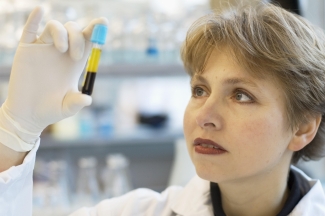This week, we chat with Canadian Blood Services’ adjunct scientist, Dr. Elisabeth Maurer, about her work to understand blood platelets for transfusion, the technology she has developed to help determine “what’s in the bag”, and what inspires her to keep researching these small but dynamic cell fragments that are so critical to bleeding, clotting, and the immune system.
Where do you work and what is your role?
I work at LightIntegra Technology Inc., a company that was founded in 2008 while I was scientist at Canadian Blood Services. I am the chief technology officer. I also hold a position as clinical associate professor at the University of British Columbia.

Tell us about your area of research...
My research is all about platelets. It started with my PhD project on dynamic light scattering (DLS) and platelets, which had the lofty goal to determine whether dynamic light scattering could be used to diagnose patients with atherosclerosis. At that time, nobody had used dynamic light scattering — a technique which uses lasers to measure the size of molecules or particles in solution — for platelet testing, let alone in a clinical setting, so I had to find out what the best conditions were for measuring live platelets. I quickly learned that these tiny cells are very sensitive to any kind of stress, and I was most intrigued by their temperature sensitivity. Platelets dramatically change their shape when exposed to room temperature, which prompted the question of its biological purpose. Platelets are the primary carriers of serotonin in the blood, and since one of the parameters that is controlled by serotonin is body temperature I thought that this might provide the link.
I developed an assay for serotonin and found very interesting connections: circulating serotonin is only present in warm-blooded animals (including humans)1 and the serotonin content in platelets changes when platelets are exposed to different temperatures.2 As activated platelets are more sensitive to cooling, I incorporated this temperature sensitivity to test platelet activation status with ThromboLUX, a machine that measures dynamic light scattering.
"It is my vision that my work could improve the lives of others — if screening platelets could help reduce the number of patients who do not respond as well as hoped to platelet transfusion, and save more lives, this would be very rewarding.”" ~ Dr. Elisabeth Maurer, adjunct scientist, Canadian Blood Services
Learn more about how Dr. Maurer uses dynamic light scattering to assess platelet quality here.
Interestingly, platelets form microparticles – small membrane-bound vesicles that fragment off the platelet – during activation, and it turned out that a high microparticle content predicted a higher temperature sensitivity, so now the focus is on microparticles. Recently I have been fascinated by how this all came together, and I have visualized the connections in what I call the Map of the World of Platelets, a work in progress.
What expertise/knowledge/experience led you to becoming a Canadian Blood Services adjunct scientist?
I bring to Canadian Blood Services my passion for platelets and my desire to improve patient care. I worked as a Canadian Blood Services scientist for 12 years before I started LightIntegra to continue the development of ThromboLUX, a system to determine platelet activation status based on the level of fragmentation into microparticles. The early patents around the ThromboLUX technology are owned by Canadian Blood Services and licensed to LightIntegra.
ThromboLUX allows quick routine screening of platelet-rich plasma from donors or samples from platelet concentrates for transfusion. From thousands of tests performed in laboratories worldwide we learned that microparticles are early indicators of platelet activation, and are associated with many conditions, even when a person has mild or no symptoms. Up to 50% of North American platelet donations may actually contain activated platelets, and I believe that these are not optimal treatment for blood cancer patients. They modulate the immune system, may inhibit T-cells (white blood cells) and are quickly removed from circulation, thus not providing the intended benefit to these patients.
However, activated platelets are stickier and it has long been suggested that they are the preferred treatment for actively bleeding patients, for example wounded soldiers. I very much hope that blood banks will embrace a routine practice of screening their platelets for activation status and directing non-activated platelets for transfusion to blood cancer patients and activated platelets to bleeding patients. Since Canadian Blood Services is one of two providers of platelets in Canada, I hope that increasing evidence will benefit not only Canadian Blood Services, but also the hospitals and patients Canadian Blood Services serves.
How does being a Canadian Blood Services adjunct scientist influence your work?
I participate in webinars and educational calls which allow me to learn about new developments at Canadian Blood Services and in transfusion medicine in general. Canadian Blood Services is one of the most progressive suppliers of blood products in the world and Canadian Blood Services’ scientists are doing cutting edge research. As an adjunct scientist, I benefit from the tremendous knowledge base and access to technology, as well as to blood products through Canadian Blood Services' blood for research lab, a special blood donation clinic and small-scale production facility in Vancouver linked to the Centre for Innovation, where blood from deferred donors is collected and used in research projects.
What are you working on now?
I am working on the ThromboLUX microparticle test to screen for platelet activation status. I collaborate with many scientists worldwide to understand donor variability and its effect on platelet products and most importantly the impact platelet activation status has on blood cancer patients. Preliminary data suggest that exclusively transfusing non-activated platelets to blood cancer patients reduces the number of transfusions they need, and thus reduces the number of refractory cases. It is my vision that my work could improve the lives of others – if platelet screening could reduce platelet refractoriness and save more lives this would be very rewarding.
Why did you get into science?
I studied chemistry because I was intrigued by the amazing concept that a finite number of building blocks – the elements of the periodic table - make up everything. I wanted to learn how millions of different substances are formed from these building blocks and how their interactions produce and sustain life – or not.
What inspires you?
Opportunities to learn inspire me. This is not limited to scientific learning, it also includes spiritual learning and new physical experiences. I love to find out more and connect the dots, fit the pieces of a puzzle together, see things from different perspectives — for me life is just one fascinating journey. Sometimes I find it difficult to prioritize.
What do you find most exciting about your work?
How everything comes together like the pieces of a puzzle. When the pieces fit like they do in the Map of the World of Platelets it is directly applicable to my own health so my work is a constant learning experience about myself and the world around me and that is wonderfully exciting. The other part is sharing what I have learned with others so they can hopefully also benefit.
What work are you most proud of?
I would like to rephrase this question a bit because what I am most proud of is, at the same time, what required the most help from others for which I am immensely grateful. I am proud of LightIntegra and ThromboLUX which at all stages required team work from highly dedicated, enthusiastic and skilled people, as well as the understanding and support of family and friends.
When you’re not in the lab where could we find you?
I actually spend most of my working hours in offices, but when I am not at work you can find me on a yoga mat, somewhere in nature with my family – like hiking the North Coast Trail with my husband Norbert or in Nelson Lakes National Park in New Zealand with sons and girlfriends, or curled up with a good book. I also enjoy doing something creative like knitting my own design.

References:
1. Maurer-Spurej E. Circulating serotonin in vertebrates. Cell Mol Life Sci 2005;62: 1881-9.
2. Maurer-Spurej E, Pfeiler G, Maurer N, Lindner H, Glatter O, Devine DV. Room temperature activates human blood platelets. Laboratory Investigation 2001;81.
Canadian Blood Services – Driving world-class innovation
Through discovery, development and applied research, Canadian Blood Services drives world-class innovation in blood transfusion, cellular therapy and transplantation—bringing clarity and insight to an increasingly complex healthcare future. Our dedicated research team and extended network of partners engage in exploratory and applied research to create new knowledge, inform and enhance best practices, contribute to the development of new services and technologies, and build capacity through training and collaboration. Find out more about our research impact.
The opinions reflected in this post are those of the author and do not necessarily reflect the opinions of Canadian Blood Services nor do they reflect the views of Health Canada or any other funding agency.
Related blog posts
Meet Dr. Elisabeth Maurer: she uses lasers to measure quality of platelets
